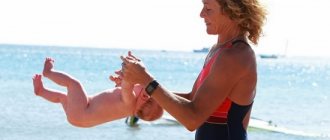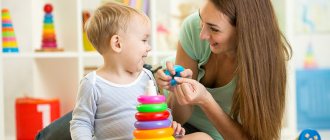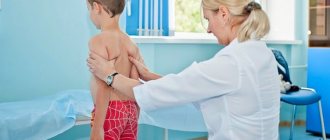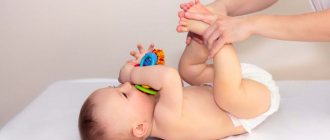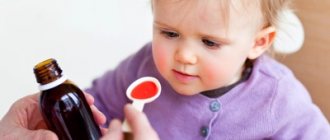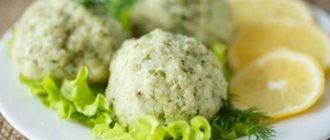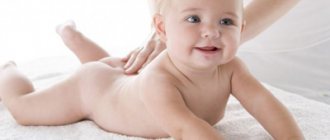Much has already been written about the benefits of massage for adults.
Imagine the benefits it has for newborns, because for them small strokes, exercises and massaging movements are an excellent way to strengthen not only the muscles, but also the nervous system of the developing body. Moreover, it is not for nothing that pediatricians recommend that mothers perform infant massage on their own, because the gentle touch of their own hands gives the baby incredible pleasure and activates the functioning of his body. It is important to observe all the conditions for performing a baby massage: ventilate the room, prepare a clean hard surface
Calm down and trust your intuition
There is no need to worry about the fact that you have not yet completely settled down and are not accustomed to the appearance of a new member of your family, that you are not doing everything perfectly, and you think about a massage with horror, for fear of hurting your child or do something wrong. Firstly, everyone learns this at some point, no matter how you will have to massage your baby, and secondly, trust your intuition, it will tell you how to care for your baby. After all, you have probably already tried to make some kind of massage movements intuitively, for example, when a child cried, you stroked his tummy with gentle movements, believing that it was he who was the cause of his whims. Or trying to calm him down, they stroked his head or back. All this is the massage movements that your parent’s heart tells you. It is only important to remember that infant massage must be done with soft and careful movements, as well as choosing the right place and time for this.
It is best to start the massage with gentle strokes and do not forget about kind words that will help the baby get used to the new sensations.
Important requirements for infant massage
First of all, it is necessary to remember that infant massage can be done starting from two weeks of age, if there are no contraindications from doctors, but it is best to start more active physical exercises after two months. The massage is performed at a temperature of 20-22 degrees in a well-ventilated room approximately 30 minutes before the intended feeding or 40-50 minutes after it. The most optimal time for a massage is in the evening, that is, after bathing, when the baby is rested and relaxed. The baby massage procedure takes about 6-8 minutes in the first months, and by five months the time increases to 15-20 minutes.
It is very important to completely undress the child before the massage, and use special oil to perform massage movements. The surface on which the baby will be massaged must be hard enough. After completing the massage, the baby should be wrapped in a soft diaper and allowed to rest. By the way, as many doctors note, the benefits of massage increase when, during its performance, adults accompany their movements with affectionate words and talk to the baby. This will allow the child to get used to the massage procedures and form a positive reaction to all manipulations.
Massaging the baby's arms is the first stage: perform light strokes, starting from the forearm and moving smoothly to the wrist
Children's exercises for children of different ages
If you start learning gymnastics from early childhood, then, most likely, in the future gymnastics will be perceived as an obligatory part of life. At the same time, it is important to correctly correlate the physical training complex and age.
1 year
The baby is not yet able to concentrate on one activity for a long time and is just learning to control his own body. Therefore, gymnastics is carried out for a short time, in a playful way and with the help of an adult. At an early age, exercise helps the baby learn to sit independently, and later it helps him learn to crawl correctly and quickly.
The figure shows an example of such a complex for one year of age
By the age of one and a half years, you can add other movements:
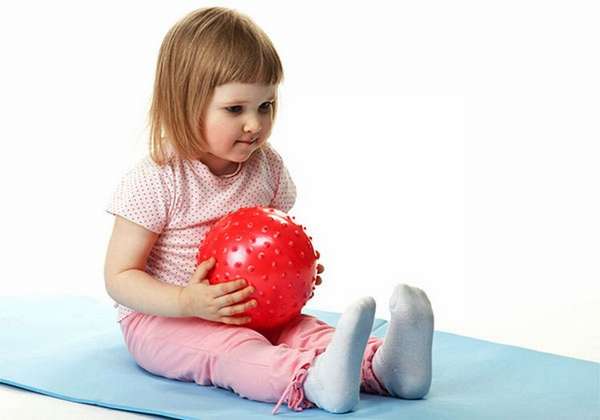
All movements should be presented in a playful, entertaining form so that they serve as a source of joy.
By the age of two, the baby will be able to make side turns from a standing position, jump on the spot, throw a ball into a basket or other target, and flap his arms “like wings.” Some of the exercises for children 2 years old can be done during a morning walk:
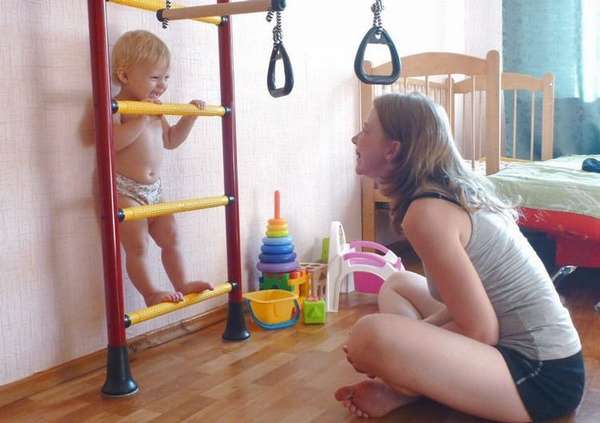
2-3 years
For children 2-3 years old, it is very interesting to repeat the movements of adults, so it is better to do exercises for children 3 years old together with their parents. Class time at this age is 4-5 minutes. It is more interesting if the whole complex is carried out in the form of a game.
The figure shows an example of such a ball game complex:

The complex begins and ends with breathing exercises:
- Take a couple of deep breaths: inhale with the ball above your head, exhale in front of you.
- Moving your head up and down.
- Tilt down towards the ball.
- Bend to the sides with the ball raised above your head.
- Squats, you can hold the ball in your hands.
- Jumping on one leg, or, if the child has not yet mastered this skill, then on two.
- Running with knees raised.
- Normalization of breathing, 3-4 deep breaths.
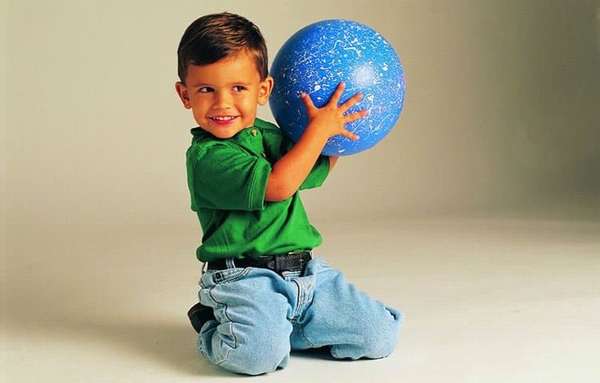
4-6 years
Older preschoolers deftly control their own bodies, and they enjoy repeating quite complex movements after adults. Exercise for children 5 years old is also better done in a playful form, because play continues to be the main activity. The average duration of gymnastics is 8-10 minutes. Older preschoolers, like younger children, will do gymnastics in poetic form with interest; each movement is repeated 5-6 times.
The sequence will be like this:
- Exercises with a jump rope (grab the cord, calmly raise and lower your arms). On inhalation, the arms are raised, on exhalation, they are lowered.
- Bend over, holding a folded rope, hands up. The task is to touch the floor with the jump rope.
- Mill - rotation with hands back and forth.
- Turns left and right, hands on the belt.
- Squats.
- Lunges left and right.
- Jumping on two and one leg.
- Finish with breathing exercises. Take a deep breath, and as you exhale, make a long “kwaah.”
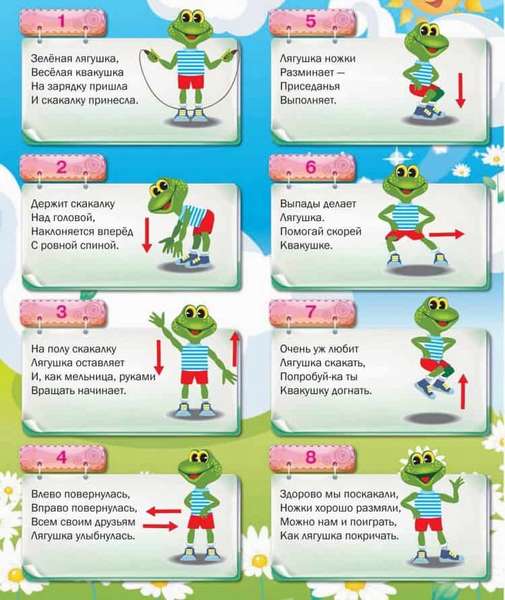
From the age of five, a preschooler becomes very dexterous and physically developed. And although one of the consequences of increased cognitive and physical activity is the crisis of 5 years, another side of development will be a large number of new skills. A five-year-old can easily be taught to ride a bicycle or enjoy rollerblading. That is why for older preschoolers, daily exercise is simply necessary so that the muscles can cope with increased physical activity.
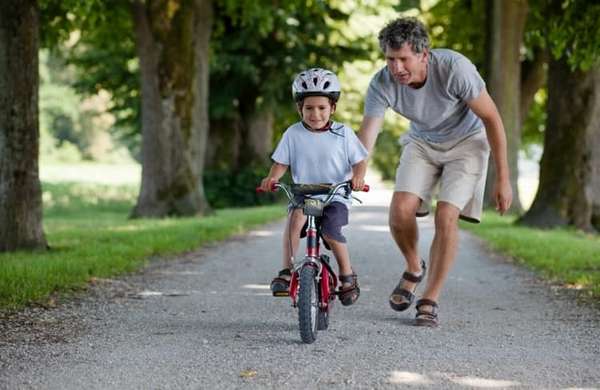
7-9 years
A morning physical education session will help a younger student feel more energetic, better adapt to school stress, and saturate the muscles with oxygen. Gymnastics is especially necessary for children who do not attend sports clubs. 10-15 minutes daily will be enough for the muscles to receive the necessary load and stretch.
A full complex consists of 12 exercises
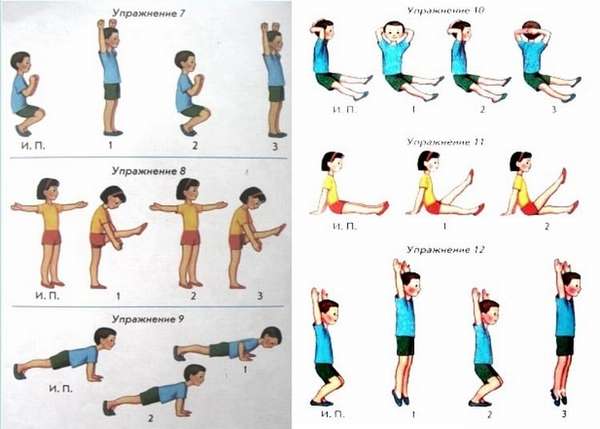
It is good to do exercises accompanied by rhythmic music. At the same time, ensure correct posture and breathing so that the child does not hold his breath. Each exercise is repeated 8-10 times.
- Start by vigorously walking in place for about a minute.
- Alternate tilts of the head to the shoulder - 4-5 times in each direction. Make sure that the child does not make sudden movements and returns his head straight to its original position.
- One hand reaches up, the other down - stretch diagonally, repeat 8 times.
- Turn the body left and right, but the feet do not move.
- A mill with a tilted body 4 times in each direction. I.p. – the body is tilted forward, arms to the sides. Turns around the waist, while the arms remain in the same plane, the left hand reaches out to the right - and vice versa.
- Tilts with two hands touching, in turn, to each leg. To the left - they straightened up, to the right - they straightened up. Total – 8-10 tilts.
- Rising from a half-squat position, raising your arms up.
- Alternating straight leg raises with clapping underneath.
- Pushups.
- Turn the torso to the sides from a sitting position with straight legs, hands behind the head.
- Alternating straight leg raises from a sitting position.
- Jumping up with your arms raised.
The complex is completed with breathing exercises: from a standing position, while inhaling, slowly rise on tiptoes, count to 3, and lower your entire foot. As you exhale, bend down as low as possible, trying to touch your toes, count to 3, and return to the starting position.
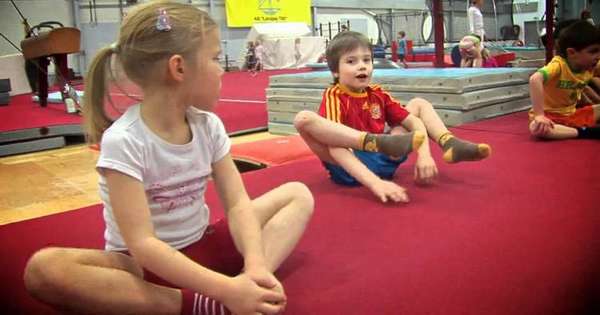
The main thing in massage is movement technique: massage the hands
The massage technique for infants is quite simple, and even if you have never performed massage movements, you can master it very quickly. Having previously warmed your hands, you first need to start massaging the baby’s hands. To do this, just place your thumb in the baby’s palm and gently stroke with your other hand, starting from the forearm and returning to the wrist. Such movements will allow the child to relax and get used to new sensations. Massage movements of the hands are recommended by doctors as an excellent remedy for such an unpleasant condition as hypertonicity, in which the muscles of the arms and legs of a healthy baby are constantly present up to the age of three months.
Massage movements not only help strengthen the muscles of the baby, but also serve as a prevention of hip dysplasia
Conclusion
Exercise therapy has a multifaceted effect on the baby’s body. Physical education activates the functioning of systems and organs: blood supply to muscles increases, oxidative processes are accelerated, waste products of cells are better removed, bone tissue and ligaments are strengthened and developed.
In addition, physical activities with the child bring many positive emotions to mother and baby.
In this article I will tell you how to strengthen the muscles of a child’s arms with the help of gymnastics and massage. My recommendations apply to infants. In order to choose the hand exercises that your child currently needs, determine whether he has sufficient muscle strength and whether he can acquire the motor skills needed at his age.
Try testing the flexor (biceps) and extensor (triceps) muscles of your arms. Biceps, or biceps brachii muscle. The test is performed with the child lying on his back, with his head and shoulders slightly raised; place a thin pillow under his head for protection. Place your thumbs in the child's hands, and use your other fingers to grasp the outside of the handle. Pull slowly towards you, lifting the child's torso above the table surface. Take your time, wait until the child bends his arms at the elbow joints and at the same time raises his head above the table. In the absence of muscle strength and muscle tone, the child’s arms will remain straight at the elbow joints and the head will be thrown back.
The triceps, or triceps brachii muscle, occupies the entire back surface of the shoulder. Performs extension in the elbow and shoulder joints. Testing can be done from 3–4 months of age, after the physiologically increased tone of the arm flexor muscles, which counteract the extensor muscles, has normalized. The test is carried out if the baby, lying on his stomach, has confident support of his hands on his forearms. To test the arm extensor muscles, place your palm under your baby's chest and lift your baby's torso slightly off the table while he or she tries to straighten his arms. If the result is negative, the child’s arms do not straighten at the elbow joints, and he does not hold his torso on straight arms. Having made conclusions after testing, try to train your baby using the proposed exercises and supplementing the gymnastics with classic baby massage. Instructions on how to strengthen your child's arm muscles with exercises are given below.
1. The baby lies on the table on his back with his head and shoulders raised at an angle of 45 degrees using a hard pillow. Place your thumbs in the child's hands, and use your other fingers to grasp the outside of the handle. Slowly pull the baby's arms towards you, but do not allow his head to rise above the surface. It is necessary to achieve active tension of the arm flexors with their further bending at the elbow joints. Repeat the exercise 5-7 times.
Once your baby develops active flexion of his arms when pulling up, help him lift his head above the surface by placing your palm under the back of his head and shoulders. Hold this position for 3-5 seconds, gradually increasing the duration. Repeat the exercise 5-7 times.
If the baby manages to group himself while lying on a hard pillow, i.e. raise your head and bend your elbows, when you pull him up by the arms, then the previous exercise should be repeated without a pillow under your head up to 5-7 times.
If the child easily performs the previous exercise, try repeating it for each hand in turn. At the same time, with one hand, hold the baby’s legs in the hip area so that they do not rise above the table surface. Repeat the exercise 3-5 times on each side. In this case, the baby can initially help himself with his free hand, pushing off from the table surface.
If your baby can briefly hold his head while lying on his stomach, try bending his arms at the elbow joints in front of his chest and holding him in this position for 4-5 seconds. Repeat the exercise 3-5 times.
If the child begins to independently rely on his forearms for a short time, grab the bent elbow joints with your palms and slightly raise your shoulders above the table surface. Hold your baby in this position for 3-5 seconds. Repeat the procedure 5 times.
Next, complicate the previous exercise: in the same position, swing it to the sides, transferring your body weight from one forearm to the other for 4-6 seconds. Repeat the procedure 2-3 times.
If the child has confident support on his forearms while lying on his stomach, teach him to straighten and lean on his outstretched arms. To do this, hold the baby in the chest and pelvis area, face down. Lift it above the table with a hovering motion toward you, and move it with your palms along the surface. Stop at the end of each movement and briefly shift his body weight onto his straightened arms. Repeat the exercise 5-7 times.
Give your child the opportunity to hold himself on outstretched arms. Stimulate him for this by pushing his chest up with your palm. Let the time during which the baby maintain this position be determined by his desire.
The next exercise is walking on your hands. Take the baby in your arms with his back to you. Hold it in the chest area with one hand, and in the pelvis area with the other. Move him to a horizontal position so that he rests his hands on the table. At the beginning of a motor skill exercise, help him move his hands. Repeat the exercise 2-3 times. In this case, the minimum load on the child’s arms will be if you support him in the chest and pelvis area. As muscle strength in the arms increases, the exercise can be made more difficult by supporting the child only in the pelvis and legs.
how to strengthen baby's arm muscles
A good addition to the exercises would be a hand massage. It can be used before or after exercise. How to strengthen the muscles of a child’s hands with the help of massage, see the link hand massage.
*Articles on massage, exercise therapy and doctor’s recommendations are for informational purposes only and do not constitute advertising of services.
The first six months are a very important period in a child’s life. During this time, many changes occur, both in the physical and psychological development of the baby. An important stage in physical development in the second half of life is the ability to crawl and then walk. Gymnastics for a 6-month-old child is necessary in order to properly prepare him for this, strengthen his muscles, and develop certain skills.

Baby on tummy
Let's not ignore the tummy
Massage of the baby's chest and tummy is performed while the baby is lying on his back. Starting with light stroking with the fingertips, circular movements are performed both clockwise and counterclockwise. Next, the hands stroke the baby’s tummy in a circular motion, avoiding the groin area and the area of the right hypochondrium. Massaging the tummy is very useful when the baby suffers from colic, because gentle stroking in this area not only helps strengthen the abdominal muscles, but also improves bowel function.
In general, massage for infants is an excellent prevention of hip dysplasia, and in some cases it can serve as a remedy.
